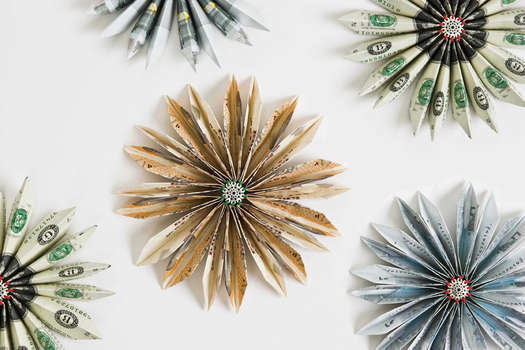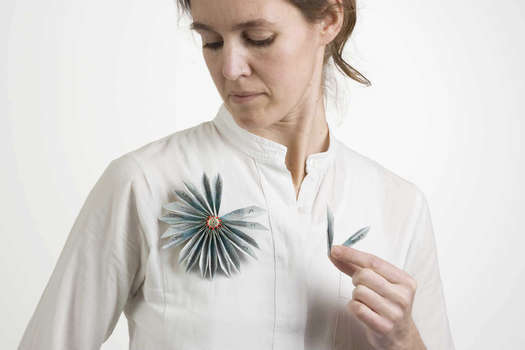power-flower (2008)
“power-flower” is both a brooch and a billfold– a flower made of silver and dyed elastic thread with folded bills inserted as petals. It is easy to pull out the bills and spend them, and the brooch is also decorative when it only has a single petal. The product comes with folding instructions, so the wearer can fold new petals.
Serving as a status symbol has always been one of the basic functions of jewellery, although status is a variable concept. “power-flower” is an image of today’s focus on economic prosperity, material goods, and consumption – a far cry from the flower-power values of the 1960s. Even among modern brand name enthusiasts, however, there is a certain reluctance to flaunt one’s money quite as obviously as the “power-flower” suggests.
“power-flower” plays with the similarity with another iconic flower brooch: Georg Jensen’s daisy brooch, which is the essence of tradition, good taste, and quality craftsmanship – a different set of values and a more discreet form of “flaunting”. Due to the historical association of the brooch to the Danish royal family and the choice of the daisy as Denmark’s (unofficial) national flower in the 1980s, Georg Jensen’s brooch is considered especially Danish. The “power-flower” gives the national aspect an extra twist with its use of money as an element – thus, the brooch may be seen as a contribution to the debate about replacing the Danish currency with the euro. However, it may also be worth considering whether it is a typical Danish “Jante Law” trait to see the “power-flower” as a status symbol lacking in sophistication.
“power-flower” also invites a discussion about the connection between money and nature in a world where nature is increasingly laid waste to satisfy the needs of modern man. In a very literal and symbolic way, “nature” gradually disappears, as the money is pulled out of the “power-flower”. At the Biennale for Craft and Design in 2009, which had “Sustainability” as its theme, the “power-flower” received the Biennale Award.

